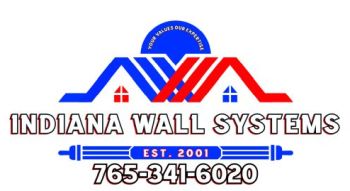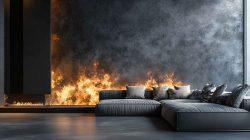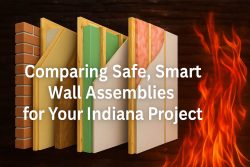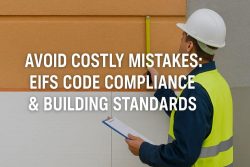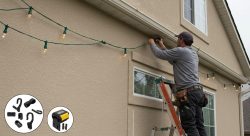Discover The Truth About EIFS Fire Ratings And Keep Your Home Safe
Many homeowners worry about fire safety when choosing exterior wall materials. EIFS (Exterior Insulation and Finish Systems) can meet strict fire safety codes and are rated non-combustible for high-temperature uses.
This blog will explain EIFS fire ratings in simple terms and help you understand if your stucco system offers proper protection. Your family’s safety matters.
Key Takeaways
- EIFS systems can earn non-combustible fire ratings when properly installed with fire-resistant base coats and finish layers.
- Fire tests like ASTM E119 and NFPA 268 check how well EIFS resists flames and heat from nearby fires.
- Unlike vinyl siding that can melt in fires, EIFS contains multiple layers that help stop flames from spreading.
- Proper installation by certified pros is key to maintaining EIFS fire safety ratings.
- Regular checks and prompt repairs of cracks or holes keep your EIFS system’s fire protection working right.
What Is EIFS?
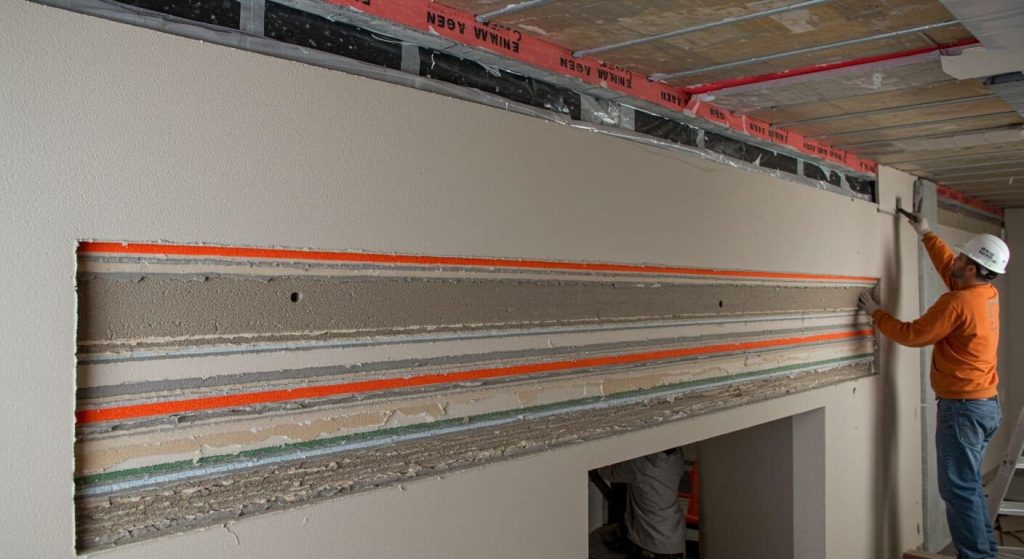
EIFS stands for Exterior Insulation and Finish System, a modern cladding that looks like stucco but offers better insulation. This multi-layered system combines foam boards, fiberglass mesh, and special coatings to create an energy-efficient exterior for buildings.
Definition and Overview of EIFS
EIFS stands for Exterior Insulation Finishing Systems. This wall coating system consists of multiple layers that work together to protect buildings. These layers include insulation board, base coat with mesh, and a finish coat.
Unlike traditional stucco, EIFS offers both decoration and insulation in one system. The outer surface looks like stucco but hides foam insulation underneath.
Property owners choose EIFS for its energy savings and design options. The system can be shaped into many forms and textures. Fire-tested EIFS passes strict safety tests and meets building codes for fire resistance.
Each layer plays a role in fire safety – from the non-combustible base coat to the protective finish layer. Regular checks by EIFS pros help keep these fire-resistant properties working right.
How EIFS Differs from Traditional Stucco
Traditional stucco and EIFS look similar from a distance but have major differences. Traditional stucco is a cement-based material applied over metal lath in multiple layers. It needs time to dry between coats and creates a hard, rigid surface.
EIFS consists of layers – a base coat, insulation board, reinforcing mesh, and a finish coat. The system provides better energy efficiency because of its continuous insulation layer.
EIFS weighs less than traditional stucco and offers more design options. You can shape EIFS into curves, arches, and other details that would cost much more with traditional stucco.
The fire ratings also differ between these exterior cladding options. Fire-tested EIFS systems can meet strict safety codes and are rated non-combustible for high-temperature uses.
The multiple layers help contain sparks and resist fire spread. Traditional stucco offers good fire resistance too, but lacks the insulation benefits of EIFS. Both systems need proper installation to maintain their fire-resistant properties.
Cracks or damage must be fixed right away to keep the wall system safe and intact.
Understanding Fire Ratings for EIFS
Fire ratings tell you how well EIFS can stop flames from spreading through your building. These ratings come from strict lab tests that measure how long materials can hold up against intense heat and fire.
What Are Fire Ratings?
Fire ratings tell you how long building materials can resist flames before they fail. These ratings come from strict lab tests where materials face extreme heat for specific time periods.
For EIFS systems, ratings measure how well the entire wall assembly – from the substrate to the finish coat – holds up during a fire. Most building codes require EIFS to pass tests like ASTM E119 and NFPA 268 to prove they won’t catch fire easily or spread flames.
Property owners need these ratings to ensure safety and meet insurance rules. A good fire rating means your EIFS cladding system can contain sparks and resist high temperatures. The multiple layers in properly installed EIFS work together to create a non-combustible barrier that protects your building’s structural integrity.
This gives you peace of mind knowing your synthetic stucco system meets safety standards and helps shield your property during fire events.
Fire Test Standards for EIFS (ASTM E119, NFPA 268)
EIFS systems must pass strict fire tests to meet building codes. The ASTM E119 test checks how long walls can resist fire before they fail. This test puts EIFS through extreme heat to make sure the system can contain flames and protect your home.
NFPA 268 tests how EIFS reacts to heat from nearby fires. This test makes sure sparks from a neighbor’s house won’t ignite your walls.
Fire-tested EIFS provides multiple layers of protection that can contain sparks and resist flames.
These tests help prove that properly installed EIFS can be fire-resistant. Your EIFS contractor should only use systems that have passed these tests. The base coat and finish in EIFS play a key role in how the system stands up to fire threats.
Next, we’ll look at the specific fire-resistant parts that make up an EIFS wall system.
Importance of Fire Ratings in Building Safety
Fire ratings matter for your property’s safety and value. These ratings show how long building materials can resist flames before they burn or fall apart. Strong fire ratings mean more time for people to escape during a fire emergency.
Your insurance company also cares about these ratings – better fire protection often leads to lower premiums. Building codes require specific fire ratings for walls, roofs, and other parts based on the building type and location.
Fire-tested EIFS systems pass strict tests for fire resistance and must meet code requirements to be used in construction. The multiple layers in properly installed EIFS contain sparks and slow down fire spread, giving you peace of mind about your property’s safety.
Fire-Resistant Properties of EIFS
EIFS systems offer strong fire protection through special materials in each layer. The base coat contains minerals that resist flames, while the finish coat adds an extra shield against heat and fire spread.
Noncombustible Elements in EIFS Layers
EIFS systems contain several fire-resistant parts that help keep your building safe. The base coat layer uses cement-based materials that don’t burn easily. This layer gets reinforced with fiberglass mesh that adds strength against fire spread.
Many EIFS products pass strict fire tests and earn ratings as non-combustible for high-heat areas. The outer finish coat also has fire-resistant qualities to stop flames from taking hold.
Fire safety comes from the whole EIFS assembly working together. The layers create a barrier that contains sparks and resists heat transfer. Proper installation makes sure these protective features work right.
Small cracks or holes must be fixed fast to keep the fire-resistant barrier intact. Regular checks by certified EIFS pros help maintain these safety features over time.
Continuous Insulation and Fire Resistance
Beyond the non-burning parts in EIFS layers, the continuous insulation offers strong fire protection. This solid layer creates a barrier that slows down heat transfer through walls during fires.
Fire tests show that EIFS with proper continuous insulation can meet strict safety codes and earn non-combustible ratings for high-heat uses.
The thickness of the insulation matters for fire safety. Thicker panels give more time for people to exit a building if a fire starts. Property owners should make sure their EIFS system uses approved fire-tested materials that meet building codes.
Regular checks by EIFS experts help catch cracks or damage that might reduce fire resistance over time.
Role of the Base Coat and Finish in Fire Protection
The base coat in EIFS works as a key fire defense layer. This polymer-modified material creates a tough shield that slows flame spread. Most EIFS base coats contain cement that won’t burn, even at high temps.
The finish coat adds another level of protection with its non-flammable minerals. Together, these layers help EIFS pass strict fire tests like ASTM E119. Fire-tested EIFS can contain sparks and stop them from reaching the wall cavity or insulation.
The right base coat thickness matters for proper fire ratings. Professional EIFS installers apply these layers at exact depths to meet building codes. Any cracks or damage must be fixed right away to keep the fire barrier intact.
The base coat also holds the mesh that gives the system its strength during fire events. Your EIFS wall system’s fire safety depends on these layers working as a team to protect your property from heat and flames.
How EIFS Compares to Traditional Stucco in Fire Resistance
While traditional stucco offers good fire resistance due to its cement makeup, EIFS systems often provide superior fire ratings thanks to their multi-layered design and special fire-resistant components – read on to learn which system might be safer for your property.
Fire Resistance of Traditional Stucco
Traditional stucco offers strong fire protection for homes. Made from cement, sand, lime, and water, this material creates a hard shell that doesn’t burn easily. Most stucco systems earn a one-hour fire rating, meaning they can block flames for 60 minutes before failing.
This gives families precious time to escape during a house fire.
The thickness of stucco matters for fire safety. Standard 7/8-inch thick stucco provides better protection than thinner coatings. Many insurance companies offer lower rates for stucco homes because of this built-in fire resistance.
Unlike some siding options, properly installed stucco won’t melt or feed flames during a fire emergency.
EIFS vs. Traditional Stucco: Key Differences
While traditional stucco offers good fire resistance, EIFS systems have key differences in their makeup and performance. EIFS uses layers that include insulation boards, mesh, base coat, and finish coat – creating a system that can pass strict fire tests.
The foam insulation in EIFS gets covered with fire-resistant materials that help contain sparks. Unlike regular stucco, EIFS needs proper sealing at all joints to maintain its fire rating.
The biggest contrast lies in how each system handles heat. EIFS includes special non-combustible elements that make it suitable for high-temperature areas. Fire-tested EIFS systems can meet building codes that regular stucco might not achieve.
Many property owners choose EIFS for its dual benefits – it resists fire while also providing better insulation. Cracks in either system need quick repairs, but this is extra important with EIFS to keep its fire-resistant properties working right.
EIFS vs. Traditional Building Materials Comparison
Making smart choices for your property’s exterior requires understanding how different materials stack up. EIFS offers unique advantages over traditional building materials in terms of fire safety and other key features.
| Feature | EIFS | Traditional Stucco | Brick | Vinyl Siding |
| Fire Resistance | Rated non-combustible for high-temperature uses; passes strict fire safety codes | Good fire resistance due to cement base | Excellent fire resistance | Can melt and release toxic fumes in fires |
| Insulation Value | Superior R-value with continuous insulation layer | Limited insulation properties | Poor insulation without added materials | Minimal insulation value |
| Weight | Lightweight (10-12 lbs per sq ft) | Heavy (7-8 lbs per sq ft) | Very heavy (40+ lbs per sq ft) | Very lightweight (1-2 lbs per sq ft) |
| Installation | Requires certified professionals | Labor-intensive, skilled trade required | Most labor-intensive, skilled masons needed | Fastest installation, less skill required |
| Maintenance | Low; needs prompt repair of cracks/punctures | Medium; may crack and require patching | Low; occasional tuckpointing needed | Medium; can crack, fade or warp |
| Cost | $25-30 per square foot installed | $15-20 per square foot installed | $35-50 per square foot installed | $5-10 per square foot installed |
| Lifespan | 30+ years with proper maintenance | 50+ years | 100+ years | 20-40 years |
| Design Flexibility | Highly customizable shapes, textures, colors | Limited textures and colors | Limited to brick patterns and colors | Many colors but limited textures |
| Water Resistance | Excellent with proper installation | Good but may absorb moisture | Good but mortar joints can leak | Excellent if properly installed |
| Impact Resistance | Good with reinforced mesh layer | Excellent | Excellent | Poor; easily dented or cracked |
Properly installed EIFS contains multiple layers that resist fire spread. The system can stop sparks and provide excellent thermal protection. For maximum safety, choose only fire-tested and approved EIFS systems that meet building codes for fire resistance and ignitability.
Regular inspections by EIFS professionals help maintain these fire-resistant properties. The combination of safety features and energy efficiency makes EIFS a practical choice for modern construction projects.
Key Factors That Influence EIFS Fire Safety
Several factors affect how safe your EIFS system will be during a fire. The quality of installation makes a huge difference in fire safety, as does your choice of materials for each layer of the system.
Proper Installation Practices
Proper EIFS installation requires trained professionals who follow industry standards. Fire safety depends on correct layering of materials and proper sealing around joints and openings.
Each layer – from the water-resistive barrier to the finish coat – must be applied at the right thickness with proper drying time between steps. Gaps or thin spots can create weak points where fire might spread faster.
Fasteners and adhesives must be used correctly to keep the system intact during fire exposure. EIFS that passes fire tests can still fail if poorly installed. Many building codes now require certified installers for EIFS projects to ensure fire-resistant properties work as designed.
Regular checks during installation help catch mistakes that might affect fire safety later.
Substrate and Insulation Materials
The base materials under your EIFS system play a huge role in fire safety. Most EIFS systems use expanded polystyrene (EPS) boards that must pass strict fire tests to meet building codes.
These boards connect to wall backings like gypsum, cement board, or plywood. Fire-tested EIFS materials can resist flames and contain sparks thanks to their special makeup. The base coat that covers the insulation contains fire-resistant elements that help protect your home.
Your choice of backing materials matters too. Cement board offers better fire protection than wood-based products. The thickness of insulation also affects how well your EIFS system handles heat and flames.
EIFS that passes ASTM E119 and NFPA 268 tests proves it can stand up to fire threats. Next, we’ll look at how building codes make sure your EIFS system stays safe.
Maintenance and Repairs
Regular upkeep of your EIFS system prevents fire hazards and extends its life. Proper maintenance helps your stucco system maintain its fire-resistant properties.
- Check for cracks or holes in your EIFS surface every three months. Small damages can grow bigger and create fire safety risks.
- Fix any damage right away. Cracks and punctures must be repaired fast to keep the fire-resistant layers working properly.
- Hire EIFS pros for yearly inspections. They spot problems you might miss and can fix issues before they become dangerous.
- Clean your EIFS walls with gentle soap and water. Dirt buildup can hide damage that might affect fire protection.
- Look for water stains or moisture issues. Wet insulation loses some fire-resistant qualities and needs prompt attention.
- Test sealants around windows and doors each spring. Failed sealants let moisture in, which can harm the fire-resistant parts.
- Trim bushes and trees away from EIFS walls. Plants touching your walls can damage the surface and create fire risks.
- Keep sprinklers aimed away from EIFS surfaces. Too much water exposure weakens the system’s fire protection.
- Watch for pest damage in your EIFS. Insects and animals can create holes that break through fire-resistant layers.
- Document all repairs with photos and receipts. This helps with insurance claims and proves you’ve maintained fire safety standards.
Let’s now explore how EIFS compares to traditional building materials in terms of fire resistance and overall performance.
Fire Safety Regulations for EIFS Systems
EIFS systems must meet strict fire code requirements to protect buildings and people. These rules vary by location and building type, with many areas now requiring special testing for wall assemblies.
Building Code Requirements for EIFS (IBC Section 1408)
The International Building Code sets clear rules for EIFS in Section 1408. Property owners must know these rules to keep their buildings safe and legal. Fire testing under ASTM E119 and NFPA 268 standards is required for all EIFS systems.
Your wall system must pass these tests to meet code compliance and ensure proper fire resistance ratings.
Fire safety codes demand that only tested and approved EIFS materials go on your building. The base coat must have glass fibers embedded in it for better fire protection. Your EIFS system needs proper drainage to prevent water damage that could weaken fire-resistant parts.
Many insurance companies check for these code-compliant features before they will cover your property.
Insurance Considerations for EIFS Projects
Beyond building codes, insurance companies have specific rules for EIFS projects. Many insurers check if your EIFS system has passed fire tests before they offer coverage. Your premiums might be lower if you use fire-tested EIFS that meets safety standards.
Insurance firms often want proof that certified pros installed your system correctly. They may also require regular checks by EIFS experts to keep your policy valid.
Getting the right insurance means showing that your EIFS can resist fire and won’t spread flames. Some companies ask for photos or reports that prove your system has proper drainage and no cracks.
Fixing damage right away helps keep your rates down and maintains your coverage. Smart property owners choose EIFS systems that pass strict fire tests – this makes getting good insurance easier and can save money in the long run.
Compliance with Local and National Fire Safety Standards
EIFS must meet strict fire safety rules at both local and national levels. The International Building Code (IBC Section 1408) sets clear standards that all EIFS systems must pass. These tests check how materials react to fire, heat, and flames.
Your EIFS needs to pass tests for fire resistance and spark control to be legal for use on your property. Most cities and states have added their own rules too, which might be even stricter than national codes.
Fire safety rules exist to protect your home and family. A proper EIFS system contains non-combustible parts that can stop flames from spreading. Your installer should provide proof that your system meets all code requirements.
This proof comes in the form of test results and product ratings. Many insurance companies now ask for this proof before they will cover homes with EIFS cladding. Make sure your EIFS professional knows all local rules – they change often as building science improves.
Common Misconceptions About EIFS and Fire Safety
Many people think EIFS systems are either completely fireproof or highly flammable, but the truth lies somewhere in between – learn what fire tests really show about these systems and how proper installation makes all the difference for your home’s safety.
Is EIFS Completely Fireproof?
No EIFS system is 100% fireproof, but high-quality systems pass strict fire safety tests. EIFS contains non-combustible elements that resist flames and can contain sparks. The base coat with embedded mesh creates a protective layer that slows fire spread.
Most systems earn good fire ratings when tested under ASTM E119 standards.
Property owners should know that proper installation matters greatly for fire safety. Cracks or holes in your EIFS need quick repair to maintain fire resistance. Fire-tested and approved EIFS meets building codes and offers better protection than untested systems.
Regular checks by EIFS pros help spot problems before they affect your wall system’s fire safety features.
Can EIFS Contribute to Fire Spread?
While EIFS systems aren’t completely fireproof, they don’t easily spread flames when properly installed. The multiple layers in EIFS work together to contain sparks and resist fire.
Fire-tested and approved EIFS pass strict building codes for fire resistance and ignitability. These systems include non-combustible elements that help stop flames from moving across your building’s exterior.
Damage to your EIFS can create fire risks. Cracks or holes must be fixed right away by EIFS professionals. Regular checks help spot problems before they become dangerous. Proper maintenance keeps the fire-resistant qualities working as they should.
Most fire issues with EIFS come from poor installation or neglected repairs – not from the materials themselves.
Addressing Moisture-Related Concerns and Fire Risks
Moisture problems in EIFS can create hidden fire risks. Water that gets trapped behind your stucco system can rot wood framing and damage the wall structure. These weak spots might fail faster during a fire.
Cracks or holes in your EIFS must be fixed right away to stop water damage that could make fire dangers worse. Fire-tested EIFS systems include special drainage features that move water away from the building.
Many property owners don’t know that wet insulation loses its fire-resistant qualities. Regular checks by EIFS pros can find moisture issues before they become fire hazards. The base coat in quality EIFS contains fire-resistant materials that work best when dry.
Proper maintenance keeps these protective layers working as designed. Your EIFS system can meet strict fire safety codes only if it stays dry and intact through its life.
Benefits of Choosing EIFS for Fire Safety
EIFS systems offer top-tier fire protection while adding energy-saving insulation to your building. They combine safety with style, giving you peace of mind and lower utility bills at the same time.
High Fire Resistance Ratings
EIFS systems offer top-tier fire protection for your property. These systems pass strict fire tests like ASTM E119 and earn high ratings that meet building codes. The multiple layers work together to stop flames from spreading.
The base coat contains special materials that resist heat, while the finish layer adds extra defense against sparks.
Your home stays safer with properly installed EIFS that meets Class A fire standards. Fire-tested EIFS can contain flames for hours, giving you valuable time during emergencies. Many property owners don’t realize that these systems can withstand high temperatures while still providing great insulation.
Regular checks by EIFS pros help maintain these fire-resistant qualities year after year.
Enhanced Thermal Performance
Beyond fire safety, EIFS offers major energy savings for your home. The system acts like a blanket around your building, stopping heat from escaping in winter and keeping cool air inside during summer.
This thermal barrier works because EIFS uses continuous insulation that covers the entire wall surface without gaps.
Property owners see real benefits on their utility bills after installing EIFS. The foam insulation layer can be adjusted in thickness to meet local energy codes while improving your home’s comfort.
Unlike traditional stucco that provides minimal insulation, EIFS creates a complete thermal shield that reduces energy waste and helps maintain steady indoor temperatures year-round.
Aesthetic Versatility with Safety Assurance
EIFS gives your home both beauty and fire safety. You can pick from many colors and textures that look just like real stucco. EIFS can be shaped into fancy details for your home’s outside walls while still meeting strict fire codes.
The system passes tough fire tests and is rated non-combustible for high-heat uses.
The layers in EIFS work together to stop sparks and resist flames. Your home stays safe and looks great at the same time. Fire-tested EIFS keeps its good looks for years with less need for fixes.
The base coat with mesh adds strength, while the finish coat guards against sun damage. Many property owners choose EIFS for both its style options and the peace of mind from its fire-resistant qualities.
Tips for Ensuring EIFS Fire Safety
Your EIFS system needs proper care to keep its fire safety features working right. You can boost your stucco’s fire defense by picking a certified system and hiring pros who know proper installation methods.
Choosing a Certified EIFS System
Always pick EIFS systems that pass fire tests and have proper ratings. The best systems meet strict building codes for fire resistance and can handle high temps without burning. Look for products tested under ASTM standards with clear fire safety marks.
Many top EIFS brands offer non-combustible options that contain sparks and resist flames. These certified systems have multiple protective layers that work together to keep your property safe.
Getting your EIFS from trusted makers matters for both safety and insurance reasons. Fire-tested systems cost more upfront but save money if a fire happens. Make sure your installer knows how to put in the system correctly – gaps or mistakes can lower fire protection.
Ask for proof that your chosen system meets local fire codes before you buy. This step helps avoid problems with inspections later.
Hiring Professional Installers
Professional EIFS installers make a huge difference in your system’s fire safety. They follow strict building codes that ensure your wall system passes all fire resistance tests. These experts know how to properly attach each layer – from the substrate to the final protective coating.
Poorly installed EIFS can create gaps where fire might spread, but certified installers prevent these problems.
Your home’s safety depends on proper installation techniques. EIFS professionals use the right mechanical fasteners and ensure correct insulation thickness throughout the system. They create proper joints and seams that maintain the fire-resistant properties of your exterior walls.
Hiring certified contractors costs more upfront but prevents expensive repairs and safety risks later.
Regular Inspections and Maintenance
Regular checks of your EIFS system help catch small issues before they become big problems. Experts suggest looking over your stucco at least once a year for cracks, holes, or damage.
These weak spots can let fire spread faster if not fixed right away. A quick repair now costs much less than major work later.
Fix any cracks or punctures in your EIFS wall system as soon as you spot them. Hire EIFS pros who know how to check the base coat, insulation layers, and finish coat for fire safety issues.
They can spot problems in the building envelope that might affect your wall’s fire rating. Most fire-tested EIFS systems keep their safety features for years when properly maintained.
FAQs About EIFS and Fire Resistance
Our FAQ section tackles your burning questions about EIFS in fire-prone areas, the lifespan of fire-resistant features, and options for upgrading existing systems to meet current safety standards – read on to learn what property owners need to know about these critical safety concerns.
Is EIFS Suitable for High-Risk Fire Zones?
EIFS can work well in high-risk fire zones if you choose fire-tested systems. These systems pass strict tests for fire resistance and must meet building codes for safety. The layers in EIFS help contain sparks and stop fires from spreading.
The base coat and finish coat add extra protection against flames.
Property owners should pick only approved EIFS products for areas with fire risks. Regular checks by EIFS pros can find cracks or damage that might create fire dangers. Quick repairs keep the system working right.
With proper care, EIFS offers both fire safety and energy savings for your building.
How Long Do Fire-Resistant Properties Last in EIFS?
Fire-resistant properties in properly installed EIFS systems can last for decades with the right care. The base coat with embedded mesh provides long-term fire protection as long as the system stays intact.
Cracks or holes must be fixed right away to keep these safety features working well. Most fire-rated EIFS maintain their protection for 15-20 years before needing major upkeep.
Regular checks by EIFS pros help spot problems early. The polymer-based materials resist breaking down from UV light and weather, which helps keep fire ratings valid. Your wall system’s fire safety depends on quick repairs and yearly inspections.
The drainage system must also stay clear to prevent moisture issues that could hurt fire resistance over time.
Can EIFS Be Retrofitted for Better Fire Safety?
Yes, existing EIFS systems can be upgraded for better fire safety. Property owners don’t need to remove the entire wall system to improve fire protection. Professionals can add fire-resistant base coats or install special barriers between the insulation and substrate.
These upgrades help meet current building codes for fire resistance. The repair process also fixes cracks or punctures that might create fire risks. Most retrofits include adding drainage systems that reduce moisture – a factor that can affect fire performance over time.
EIFS professionals can test your current system and suggest the most cost-effective safety improvements.
Let’s look at what makes EIFS fire-resistant and how it compares to traditional stucco systems.
Conclusion
EIFS systems offer strong fire safety when installed right. Your stucco system can protect your property from flames if you choose quality materials and hire skilled pros. Regular checks keep your EIFS in top shape and ready to resist fire threats.
Smart homeowners pick EIFS that meets all fire codes and standards. Your peace of mind starts with knowing your exterior wall system has the fire ratings needed to keep your family safe.
FAQs
What is EIFS and how is it different from traditional stucco?
EIFS stands for Exterior Insulation and Finish System. It’s often called “synthetic stucco” compared to traditional stucco. While traditional stucco is installed with cement, sand, and lime, EIFS uses foam insulation boards with a base coat and finish layer. EIFS generally offers better insulation, while traditional stucco gives more durability. Both can look the same on a finished wall, but the way they handle water vapor and moisture is very different.
Are EIFS wall systems fire resistant?
Yes, EIFS wall systems can be fire rated when properly installed. The materials used in best stucco systems include cementitious base coats embedded in the base coat that help slow fire spread. Fire would have trouble moving through a correctly built EIFS construction. Many systems meet building code compliance for fire resistance. However, the level of protection depends on the specific system chosen and how it was installed.
What are common defects in EIFS that might affect safety?
Common EIFS problems include water intrusion, which happens when moisture gets trapped behind the system. Improper installation often leads to these issues. Cracks may form due to building movement or poor substrate preparation. Without proper drainage EIFS, water can damage the sheathing and create mold problems. UV exposure can also damage the finish over time if proper UV protection coatings aren’t used.
How long does EIFS last and what maintenance does it need?
EIFS can last 20-30 years with proper care. Stucco needs regular checks for cracks and water damage. You should clean the surface yearly and fix any damage right away. Moisture intrusion is the biggest threat to long-term performance. Professional stucco repair services can help fix small problems before they get worse. The system should be checked after storms or high winds for any signs of damage.
What should I look for in quality EIFS installation?
Look for proper joint detailing and a working moisture drainage system. The wall systems should have good air and water barriers installed first. Check that the contractor uses either an adhesively attached system or mechanically fastened insulation correctly. The finishing options should match your needs while meeting performance standards. Indiana Wall Systems and other professional installers will focus on freeze-thaw resistance and proper vapor barrier installation.
When should I consider stucco replacement for my EIFS system?
Consider stucco replacement if you notice serious water damage, large cracks, or sections pulling away from the wall. If repairing EIFS would cost more than half of a new installation, replacement might make more sense. Homes with barrier system EIFS (older types without drainage) often benefit from upgrading to newer drainage EIFS. After 25+ years, or if thermal bridging concerns arise, replacement can improve your home’s energy efficiency and safety.
